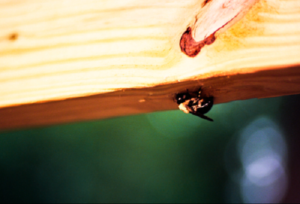Are You Laying Out a Welcome Mat for Rats?
December 21, 2017Woodpecker Damage Because of Insect Eating
April 3, 2018While many fear the stings of bees as spring begins, carpenter bees come with additional concerns when it comes to your home. These wood-boring bees may be stingless (or at least half of them), but they can do a number on the wooden parts of your home and outbuildings. Read on to discover how to tell them from other bees, what to watch for when they’ve invaded, and what to do if you suspect you have your own growing colony.
What are Carpenter Bees?
Carpenter bees can be yellow and black like honeybees and bumblebees. They are similar in size to a bumblebee, but instead of being yellow and fuzzy throughout, they have a black, shiny, hairless rear end (or abdomen). They often appear somewhat metallic in color. Some carpenter bees come in other colors like orange, greenish, or purple. Males are stingless, but females can still sting you. Carpenter bees branch out to create new colonies in the spring, so this is the time to begin watching for them on the wooden parts of your home.
Finding a Carpenter Bee Nest

Carpenter bee nests are visible as a hole about half an inch in diameter in the wood of a structure. Since the bees don’t eat the wood that they burrow into, sawdust is often found outside the hole. Males are also territorial, so they may be seen hovering outside of the hole to protect it (again, they are stingless). Inside the hole, the tunnel is typically about 6-8 inches long, going with the grain. Small egg chambers are along this tunnel, each with a bit of food for the larva when it awakens. These nests can expand year after year as the colony grows.
What to Do if You Suspect Carpenter Bees
If you think you have carpenter bees, they can be removed, and the hole can be sealed and painted once the process of carpenter bee removal is done. However, if you simply seal the hole and don’t address both the bees inside and outside of the nest, you may find that the damage continues as they try and find a way out. Working with a wildlife removal expert can offer you a number of things. You get peace of mind that the problem is fully removed and treated in a way that they are not likely to return. You get a thorough inspection of your area and suggestions on how to prevent future carpenter bee infestations. And you get the confidence that the nest that you located is the only one on your building. Speak with your local wildlife removal expert today if you suspect that you have these wood-boring insects in your home or outbuilding.

